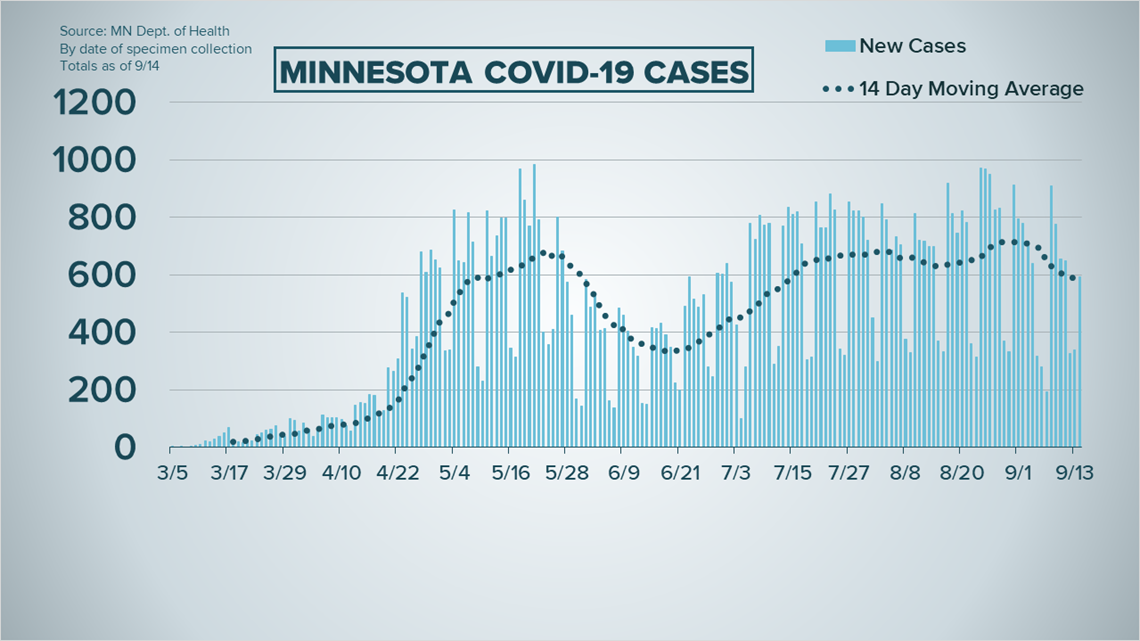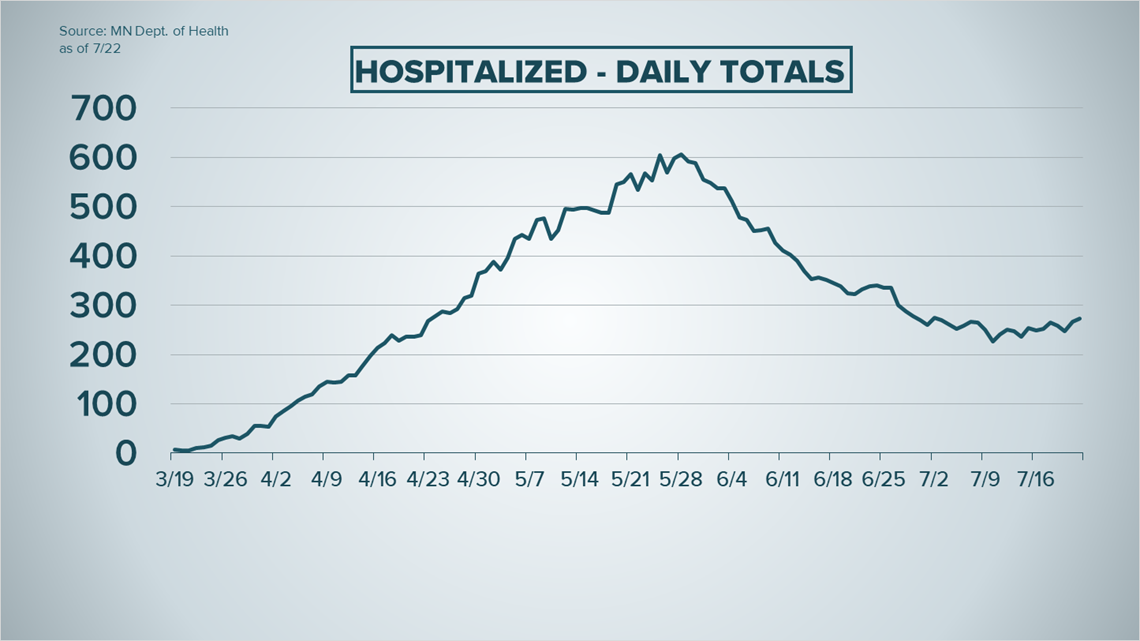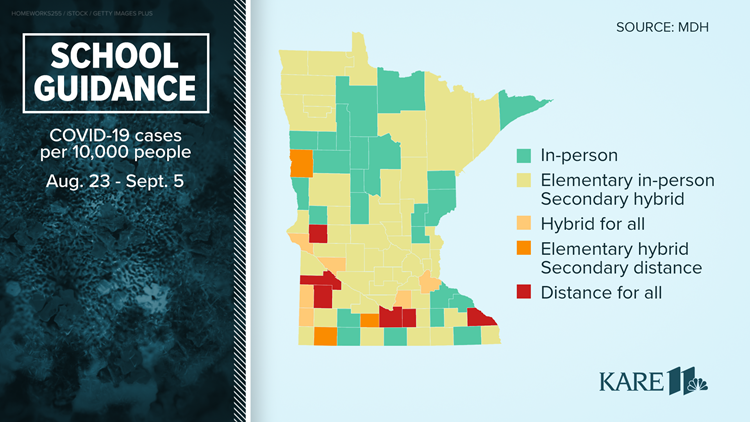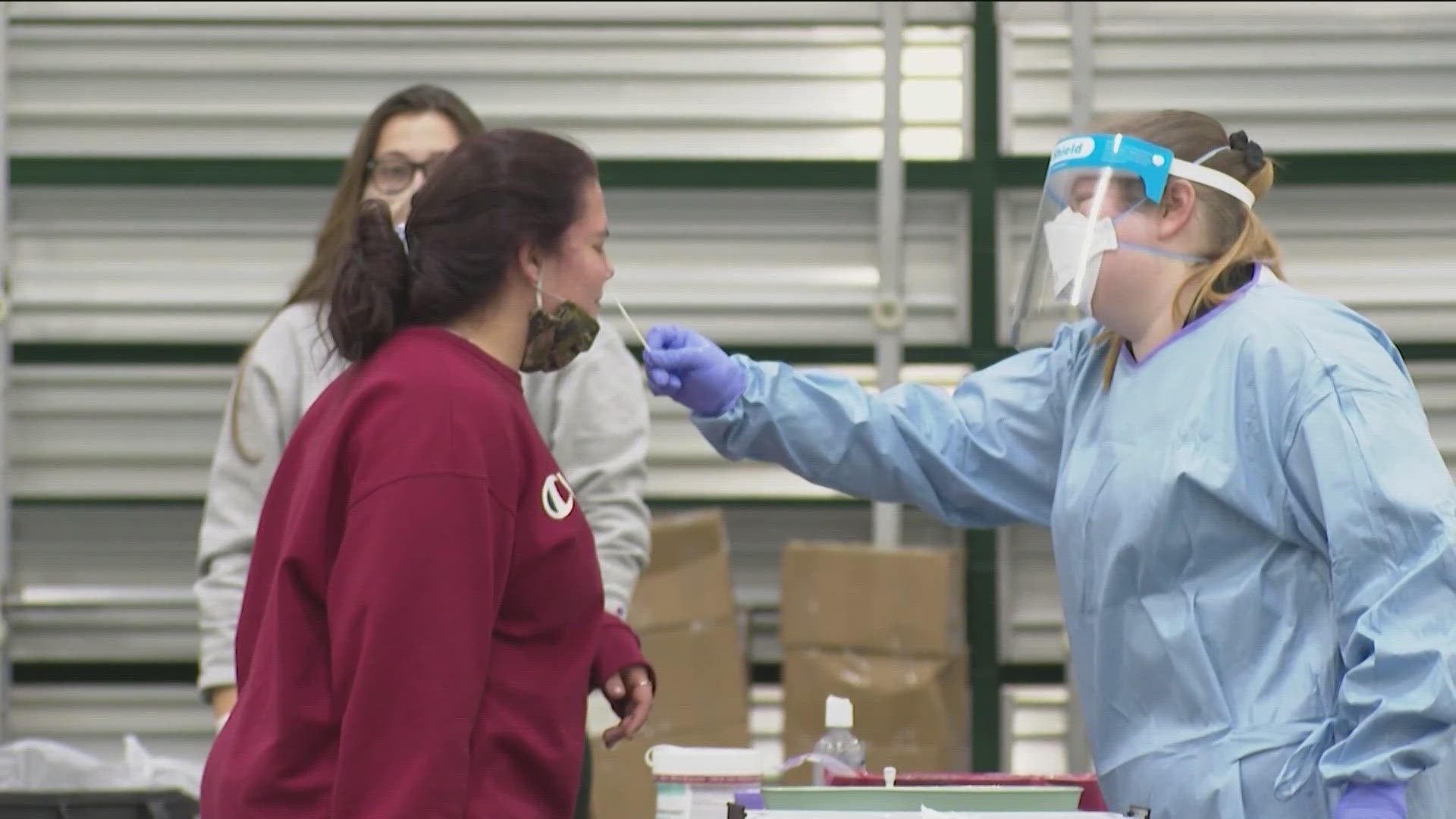ST PAUL, Minn. — Thursday, Sept. 17
- Five more counties show case rates high enough for 'full distance learning' recommendation
- MDH reports 931 new COVID cases, based on higher testing numbers
- MSHSL sued over moving football, volleyball seasons due to COVID
- MDH has a website for resources for families and those in need of child care.
- MDH will be doing free testing in Grand Rapids, Pine City and Waseca starting Sept. 21.
2 p.m.
Beginning the week of Sept. 21, the Minnesota Department of Health (MDH) will launch a four week effort to provide increased access to "no-barrier" testing: That means coronavirus tests that are free and available to anyone who wants one, whether they're showing symptoms or not.
The first week of targeted testing will occur in Grand Rapids, Pine City and Waseca.
You do not need to have insurance or an ID in order to get the free test. You only need your name and a way for officials to contact you with your test results.
Department of Health Assistant Commissioner Dan Huff said they are nervously watching what is happening in neighboring states like the Dakotas and Wisconsin. Huff hopes to increase testing. The no-barrier testing hopes to curve the recent increase in community spread, meaning decreasing the amount of people who got infected but don't know how they became infected.
12:30 p.m.
New weekly school guidance data released by the Minnesota Department of Health (MDH) shows six Minnesota counties now have COVID-19 case rates high enough for the state to recommend full distance learning, and a majority of Minnesota counties now fall under recommendations for at least some level of hybrid in-person and distance learning.
The counties currently falling under the full distance learning recommendation include Blue Earth, Lyon, Stevens, Waseca, Winona, and Yellow Medicine. Only Waseca County was in the category last week.
The guidance is based off of data reflecting COVID-19 cases rates per 10,000 people from Aug. 23 to Sept. 5. Waseca County had the highest rate in the state in that period, with 72.84 cases per 10,000 residents, up from 57.95 the week before.
State officials have emphasized that this case data alone does not automatically determine the learning plan for a particular county or school district, but is meant to be used in guidance in each district's decision-making process.
According to the state's Safe Learning Plan, the county case data leads to five recommended learning models:
- 0-9 cases per 10,000: In-person learning for all students
- 10-19 cases per 10,000: In-person learning for elementary students, hybrid learning for secondary students
- 20-29 cases per 10,000: Hybrid learning for all students
- 30-49 cases per 10,000: Hybrid learning for elementary students, distance learning for secondary students
- 50 or more cases per 10,000: Distance learning for all students
In the metro area, Dakota County reported the highest case rates for the two week period, falling under recommendations for a hybrid learning model. All other metro counties were under the recommendations for in-person learning in elementary schools and hybrid learning for secondary students.
Only 24 Minnesota counties still have case rates low enough for full in-person learning under the guidance.
11 a.m.
Numbers released Thursday by the Minnesota Department of Health (MDH) reflect a significant increase both in confirmed cases of COVID-19 and test numbers from the previous day.
MDH is reporting 931 new cases based on the results of 19,743 tests, just short of double the testing numbers reported Wednesday (9,887). That brings the total of confirmed cases in Minnesota to 86,722 since the pandemic began.
Nine more Minnesotans have died of coronavirus, bringing fatalities to 1,942. Of those deaths 1,408, or 72% of them, occurred in long-term or assisted living settings.
As of Thursday 242 people are being treated for COVID-19 in hospitals across the state, including 132 with symptoms serious enough to require care in the ICU. State health officials says 79,878 people who tested positive for the virus at one time have recovered to the point they no longer require isolation.
People between the ages of 20 and 24 continue to make up the largest subset of Minnesota's coronavirus cases with 11,828 cases and one fatality, followed by those 25 to 29 with 8,604 cases and three deaths. Minnesotans ages 15 to 19 now comprise 8,106 cases but zero fatalities.
The age group with the greatest number of COVID-19 fatalities are those from 85 to 89, with 330 deaths in just 1,178 cases. That means 28% of the people from that demographic who were diagnosed with the virus died from it.
Hennepin County has the most COVID activity with 25,264 cases and 915 fatalities, followed by Ramsey County with 10,267 cases and 314 deaths. Dakota County reports 6,942 cases and 124 deaths.
Cook County has the least coronavirus activity with just six cases, followed by Kittson County with 13 cases.


(Case averages through Monday, Sept. 14, 2020)
Wednesday, Sept. 16
2 p.m.
MDH Commissioner Jan Malcolm says Minnesota could anticipate an increase in infection numbers from Labor Day similar to the 4th of July.
State Infectious Disease Director Kris Ehresmann said the CDC has provided states with a playbook for vaccine planning. The document says that they do not know when a vaccine will be available, Ehresmann said.
There will be three vaccine phases. First phase will focus on healthcare workers and severe illness patients. Second phase will start adding general population. Third phase will mean the vaccine is available for everyone.
MDH Medical Director Dr. Ruth Lynfield said they have began a statewide survey for households to learn more about how COVID-19 has spread in the community and how infection rates differ in Minnesota regions. Households have been randomly selected. The teams going to the houses will be public health workers who will be wearing masks and will be identified as part of the survey team. The teams will offer nasal and antibody tests. Participation is voluntary and all information will be kept private, Lyfield said.
In terms of sports resuming, health officials said they understand why parents want their kids to have the experience of playing sports but that there are risks involved and researchers are still learning about health complications from COVID-19 in young people.
11 a.m.
State health officials say another 513 Minnesotans have tested positive for COVID-19 in the last day, and the virus has claimed another seven lives.
The Minnesota Department of Health (MDH) says the new cases were documented through the processing of 9,910 tests in private and state labs. They bring the state's case total since the start of the pandemic to 85,813.
Seven more deaths have been linked to coronavirus, bringing Minnesota fatalities to 1,933. Of those deaths 1,402, or 72% occurred in assisted living or long-term settings.
Currently, 244 people are being treated for COVID-19 in hospitals across Minnesota, 136 of them with symptoms serious enough to require care in the ICU. MDH says 79,583 people who at one time tested positive for the virus have recovered enough to no longer require isolation.


Those between the ages of 20 and 24 account for the largest group of Minnesota's COVID cases with 11,687 and one death, followed by people 25 to 29 who make up 8,526 cases and three deaths. Minnesotans ages 15 to 19 comprise 7,986 cases, with zero deaths.
The state's demographic with the most fatalities is those between 85 and 89. Of that age group 329 have died from a pool of just 1,169 cases diagnosed.
Hennepin County has the most coronavirus activity with 25,093 cases and 909 deaths, followed by Ramsey County with 10,166 cases and 314 fatalities. Dakota County reports 6,895 cases and 123 deaths.
Cook County in far northeastern Minnesota has the least COVID activity with just six cases and no deaths.
KARE 11’s coverage of the coronavirus is rooted in Facts, not Fear. Visit kare11.com/coronavirus for comprehensive coverage, find out what you need to know about the Midwest specifically, learn more about the symptoms, and see what businesses are open as the state slowly lifts restrictions. Have a question? Text it to us at 763-797-7215. And get the latest coronavirus updates sent right to your inbox every morning. Subscribe to the KARE 11 Sunrise newsletter here. Help local families in need: www.kare11.com/give11.
The state of Minnesota has set up a data portal online at mn.gov/covid19.



